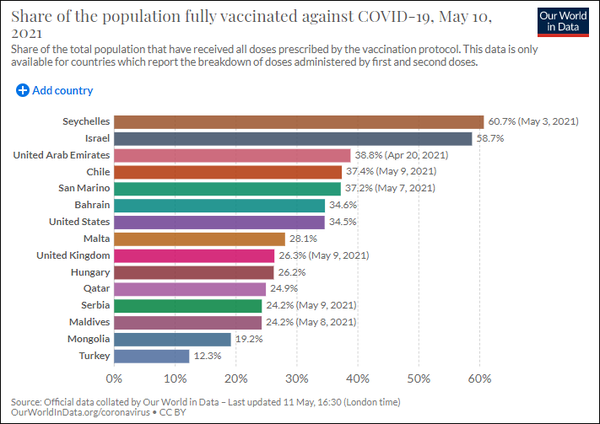Health officials in some countries are scratching their heads because their high vaccination rates did not lead to a decline in Covid-19 cases.
Such phenomenon is particularly prevalent in countries that vaccinated the population mainly with Chinese Covid-19 vaccines, and industry watchers are raising questions over the Chinese vaccines’ efficacy.
Chinese companies, including Sinopharm and Sinovac have developed Covid-19 vaccines and the Sinopharm vaccine won the WHO’s approval for emergency use on Saturday.
Seychelles is the most vaccinated against Covid-19 in the world, followed by Israel. Over 60 percent of the population in the Indian Ocean nation have received two full doses of a Covid-19 vaccine. However, unlike in Israel, the number of Covid-19 cases has recently gone up in Seychelles, which has about a population of 97,000.
According to Our World in Data, an international statistics website, 60.7 percent of the Seychelles population have been fully vaccinated against Covid-19, followed by 58.7 percent of Israel. In Seychelles, 69.2 percent of the people have received the first dose of a vaccine.
However, new daily Covid-19 cases went up to 1,799 on Thursday in Seychelles, whereas the daily number was only 63 in Israel on the same day.

The United Arab Emirates, the third most vaccinated after Seychelles and Israel, is having a similar problem. On April 20, 38.8 percent of the UAE population have received both doses of a vaccine, and 51.4 percent have got the first dose. However, daily new cases have exceeded 1,700 recently in the UAE.
Chile, ranking fourth in the vaccination rate, has vaccinated 37.4 percent of the population with two full doses and 44.8 percent with the first dose.
However, Covid-19 infections are still rampant in Chile. The new daily Covid-19 cases used to hover around 2,000 in early December. However, after the Covid-19 vaccination started, new cases rose to over 7,000 per day in March. The situation abated a little in mid-April, and the daily number fell to around 5,000 in May.
What Seychelles, the UAE, and Chile have in common is that they have inoculated their populations mostly with Chinese Covid-19 vaccines.
Over 60 percent of the population in Seychelles received the Sinopharm vaccine, and the rest, the AstraZeneca vaccine. The UAE granted the nod for the Sinopharm vaccine in December and has rolled out the vaccine swiftly since. People in the capital city of Abu Dhabi received Sinopharm vaccines only, and those in Dubai, vaccines from Sinopharm, Pfizer, and AstraZeneca.
Chile began vaccinating medical professionals with the Pfizer vaccine in December and accelerated the vaccine rollout with the Sinovac vaccine in February.
A rush in relaxing quarantine measures is cited as one of the causes of continued Covid-19 spreads.
Seychelles began to allow foreign travelers to enter the country on March 25, when the vaccination rate was below 30 percent.
As the vaccination rate increased in the UAE, health officials lifted viral curbs and maintained mask-wearing policy only.
Chile also eased social distancing rules.
The WHO approved the Sinopharm vaccine as the sixth Covid-19 vaccine for emergency use. Sinopharm vaccine can be given to adults aged 18 or older, and two doses should be administered three to four weeks apart.
The WHO said the Sinopharm vaccine was 79 percent effective in Covid-19 patients with symptoms and those hospitalized.

